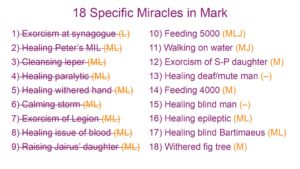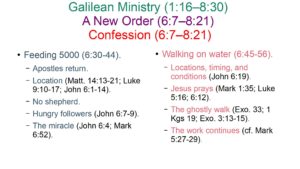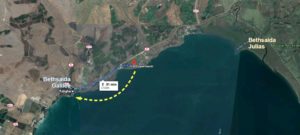The Ministry of Jesus in Galilee
Mark 1:16—8:30
A New King (1:16—3:6).
Kingdom is Near (1:15)
Popularity (1:16-45).
Conflict (2:1—3:6).
Jewish Leaders Reject Him (3:6)
A New Kingdom (3:7—6:6)
Kingdom Has Small Beginnings (4:3)
Continued Conflict (3:7-35).
Parables (4:1-34).
Identity (4:36—6:6).
Jesus’ Town Rejects Him (6:6)
A New Order (6:7—8:21)
Herod & Pharisees (8:15)
Confession (6:7—8:21).
Limited Commission (6:7-13).
John the Baptist Executed (6:14-29).
The Apostles return from the Limited Commission.
Matthew informs us this is after Jesus learns of John’s execution.
The Apostles give Jesus a full account of what happened.
No doubt they were all excited they could perform such miracles and have people repent.
Aren’t we excited and overjoyed whenever someone comes to Christ? The Apostles likely feel that adrenaline rush and can’t wait to tell Jesus all about it.
Jesus then says it’s time to rest by going to a deserted place.
Sometimes we need isolation for a little while to recharge.
What follows is the only miracle recorded in all four gospel accounts!
Where they begin is unclear, but Capernaum makes sense since it is Jesus’ headquarters.
Mark is not specific as to where they go, either, just a deserted place.
Matthew and John are equally as vague. John mentions that He was performing miracles and went up a mountain. Matthew, as Mark, says they went to a deserted place.
Luke said this deserted place belonged to the city of Bethsaida (Luke 9:10b).
Yet later, we see the disciples trying to sail to Bethsaida, but then arriving at Gennesaret (Mark 6:45, 53).
Some have thought that there are two Bethsaidas: Bethsaida Julias and Bethsaida Galilee. The one near the mouth of the Jordan River is Bethsaida Julias, and Bethsaida Galilee is where the Church of the Loaves and Fishes is—modern day Tabgha.
I think this is very likely and that the latter Bethsaida is the location in which this miracle was performed.
The multitudes could easily see their boat from the shore and could extrapolate their destination.
They end up beating them there on foot—about half an hour’s walk.
Jesus wants to be alone with His disciples, but the people won’t allow it.
Instead of getting annoyed, Jesus feels pity for them (another word for compassion).
They were like sheep not having a shepherd—lost sheep, desperate for someone to guide them.
Do we ever see people desperate for a shepherd, desperate to be guided in the right—or any—direction? Elder’s thoughts?
Jesus’ answer to their lost nature was to teach them many things—after all, that was His purpose, remember?
One purpose was to teach, and in the process, become their Chief Shepherd.
He spent all day teaching them until it was late.
Have you ever been so enthralled with something, or you’re concentrating on something so much that you forget to eat?
Imagine sitting at the feet of Jesus and just listening to all He had to teach. You are paying such rapt attention that you don’t realize how much time has past, even to the point of forgetting to eat. Wow!
It is late, and the people are hungry.
Later we find out there are 5000 men plus women and children here.
So the disciples suggests sending them into town so they can buy their own food.
Jesus says, “You give them something to eat.”
Philip (John 6:7) comes back and basically says they can’t possibly afford that much food—200 denarii. He’s asking incredulously.
One denarius was considered to be one man’s daily wage—about 7 month’s worth of wages. That makes 0.04 denarius per man per meal for bread (forgetting women and children) – though I’m sure Philip is only ballparking it at this point.
Jesus asks them how much food they have. They investigate, and Andrew comes back as states that a boy has 5 loaves and 2 fish (John 6:8-9).
The miracle.
Jesus has them sit on the green grass. This is another detail evidence of an eye-witness account found only in Mark. John states that this was around the time of Passover (John 6:4), which makes this springtime, the right time for the grass to be green in that region.
They sit down in ranks, no doubt to make it easier to count them and to distribute food.
Only the men were counted, likely heads of households so they could sit together to eat.
Jesus looked up to heaven, no doubt indicating to those around Him that this miracle is from God, that this is bread from heaven.
This is a big point that John later brings out, but Mark does not, nor do the other synoptic gospels. John’s focus is different.
We see that Jesus feeds the multitudes with bread from heaven just as Moses did with the manna—He is a new Moses to bring about the New Order.
The food is divided and everyone eats until they are full—a remarkable feat with just five loaves and two fish. But more than that, there were leftovers, 12 baskets full!
What do you suppose is the significance of their being 12 baskets left over? Later, with the feeding of the 4000, there are 7. So why 12 here? One for each Apostle, perhaps? Won’t that food spoil before too long if it goes to each of the Apostles? One for each of the tribes of Israel then?
What do we learn about Jesus from this miracle? Whatever it was, the disciples missed the lesson (Mark 6:52). This goes to further prove His identity so the disciples could make that great confession.


